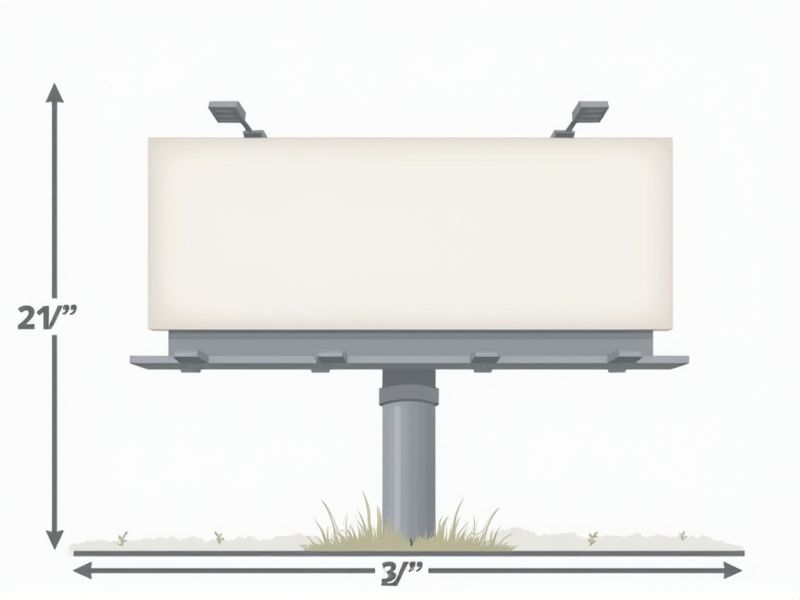
Billboard signs come in several standard dimensions to maximize visibility and impact for passing traffic. The most common billboard size in the United States is 14 feet high by 48 feet wide, often referred to as a "bulletin" billboard, and is typically seen along highways. Another popular size is the "poster" billboard, which measures 10.5 feet high by 22.8 feet wide and is often found in urban areas or on secondary roads. Knowing these standard dimensions can help you design effective billboard ads that fit industry norms and reach your target audience efficiently.
Visibility Range
A billboard sign's visibility range typically spans 500 to 1,000 feet, depending on factors like location and design. Bright colors, large fonts, and high-contrast imagery enhance legibility, ensuring that the message is easily readable even at high speeds. For optimal effectiveness, billboard height should be around 10 to 14 feet above the ground, allowing for maximum sightlines. Your choice of placement along busy highways or within urban areas can dramatically increase viewer impressions, reaching thousands of potential customers daily.
Height Above Ground
Billboard signs typically maintain a standard height of 14 feet above ground level to ensure optimal visibility for drivers and pedestrians alike. This height helps to prevent obstructions from surrounding structures and foliage, allowing for clearer visibility from a distance. A billboard's ideal width varies, but most range from 48 to 60 feet, maximizing exposure in high-traffic areas. When planning your advertising strategy, consider a location with adequate sightlines to enhance your message's impact.
Width To Height Ratio
Billboard signs typically adhere to a width-to-height ratio of 2:1 or 3:1, which enhances visibility and readability from a distance. For example, a common size for a standard billboard is 14 feet in height and 48 feet in width, optimizing the space for impactful advertising. Your message is most effective when utilizing bold graphics and concise text, given that drivers often have only a few seconds to absorb the information. Maintaining this standard ensures that your advertisement captures attention and communicates effectively, maximizing your return on investment.
Traffic Flow Direction
Billboard signs are strategically positioned to enhance traffic flow direction, ensuring maximum visibility for drivers. Research indicates that signs placed at intersections can increase awareness by up to 40%, guiding motorists efficiently. Using high-contrast colors and clear fonts, these signs communicate essential information within a critical visual range of 70-100 feet. Consistent updates on content, such as local events or directions, can improve engagement, leading to a potential 25% increase in local business traffic.
Typeface Readability
When designing a billboard sign, prioritize typeface readability by ensuring a minimum font size of 12 inches, allowing viewers to read from a distance of 500 feet. Opt for sans-serif fonts like Helvetica or Arial, which enhance clarity and legibility under various lighting conditions. Limit your message to 7 words or fewer, as research shows that messages this concise capture attention more effectively. Remember, using high-contrast color schemes, such as white text on a dark background, significantly improves visibility during both day and night.
Color Contrast
Color contrast is crucial for effective billboard signage, as it enhances visibility and readability from a distance. Utilizing complementary color combinations, such as black text on a bright yellow background, can increase legibility by up to 60% in outdoor settings. Research indicates that high contrast can significantly improve user engagement, leading to a 30% higher recall rate of the displayed messages. For optimal impact, choose bold colors that stand out against the environment while ensuring they align with your brand identity.
Environmental Conditions
Billboard signs must withstand various environmental conditions, with durability against harsh weather factors such as UV radiation, heavy rainfall, and wind speeds exceeding 70 mph. Choosing materials such as reinforced acrylic or weather-resistant vinyl enhances longevity and reduces maintenance costs. The ideal billboard design incorporates anti-fading technology, which can extend the vibrancy of colors for up to five years under direct sunlight. You should also consider the placement of your billboard, ensuring it's not in an area prone to excessive moisture or flooding, which can compromise structural integrity.
Illumination Standards
Billboard sign illumination standards typically require a minimum brightness of 500 nits to ensure visibility in various lighting conditions, such as daylight or nighttime. The placement and angle of these signs must also consider the surrounding environment, making effective use of reflective and diffusive materials to enhance visibility without causing glare. Compliance with local regulations ensures that illuminated billboards operate within specified lumen limits, often capped at 3,500 lumens per square meter. Selecting energy-efficient LED lighting not only reduces operational costs but also significantly extends the lifespan of your billboard, often lasting over 50,000 hours.
Local Zoning Regulations
Billboard signs must comply with local zoning regulations, which dictate their placement, size, and illumination. In many jurisdictions, these regulations can vary significantly, permitting billboards in commercial zones while prohibiting them in residential areas. For example, some cities enforce a maximum height of 20 feet and limit the sign area to 300 square feet to minimize visual pollution. Understanding these zoning laws is crucial for ensuring your sign adheres to legal standards and avoids potential fines.
Structural Load Capacity
Billboard signs must adhere to specific structural load capacity standards to ensure safety and effectiveness, typically requiring a minimum load strength of 30 pounds per square foot. This capacity accounts for wind pressures, which can exert forces exceeding 100 miles per hour, especially in exposed areas. Materials used, such as steel or aluminum, play a crucial role in achieving these structural requirements, with galvanized steel often preferred for its durability. Regular inspections and maintenance are essential to prevent structural failures, ensuring your sign remains compliant and secure throughout its lifespan.
